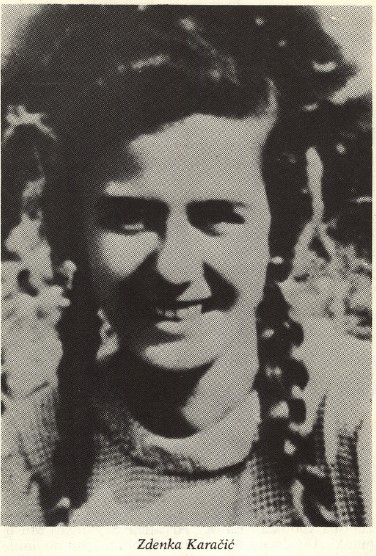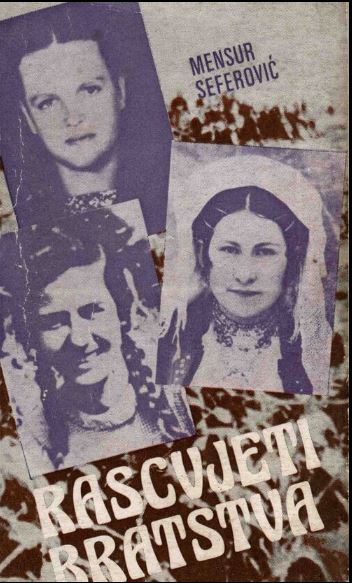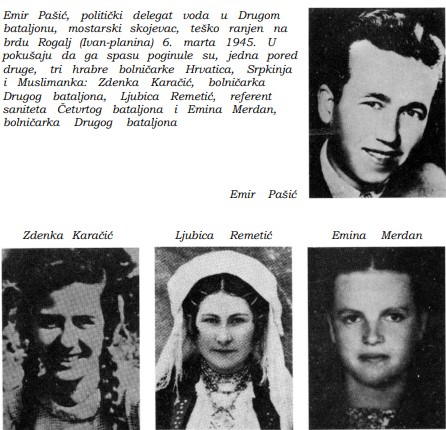
brochure "Partizanski spomenik u Mostaru" (1980)
book “Spomenica Mostara 1941-1945.”
another document or proof of the memorial stone (e.g., a photograph).
Zdenka M. KARAČIĆ
ZDENKA KARAČIĆ, daughter of MIRKO, born on October 18, 1927, in Mostar, was a student at the Commercial Academy. She joined the People’s Liberation War and Partisan Detachments in the autumn of 1944. She served as a nurse in the 2nd Battalion of the 13th Herzegovina Brigade. She was killed on March 8, 1945, at Ivan-sedlo while trying to help the wounded fighters Emir Pašić and machine gunner Toma Krajišnik. “… Besides Zdenka, two more nurses were killed on the same battlefield: Ljubica Remetić from the village of Biograd near Nevesinje, a medical officer in the Fourth Battalion, and Emina Merdan from Počitelj, a nurse in the Second Battalion. The symbolism of these sacrifices echoed in the battalion for a long time, as well as after the war, through numerous stories: “the feat of Zdenka, Emina, and Ljubica remained a symbol of the blood-sealed brotherhood and unity of our three nations.”
According to the archives of Radmilo Braca Andrić, the remains of Zdenka Karačić were transferred and buried in the Partisan Memorial Cemetery in Mostar.
Mensur Seferović wrote about this event many years after the war. As a source, he cited an article by Lutvo Džubur (“Njih tri”) published in the newspaper of the 13th Brigade, “Hercegovački borac”:
“Ljubica was the first to go. She reached the wounded comrade and pulled him. Just at that moment when she thought the task was completed, that the comrade was saved, Ljubica collapsed in the snow, hit by a shot in the stomach. Zdenka and Emina, who were closely observing Ljubica’s attempt from cover, now knew what their duty was. No orders were necessary. Conscience is stronger than anything. They rushed towards Ljubica and the wounded comrade, not thinking about the danger and disregarding the enemy bullets that were tearing through the snow around them. But… the villainous eye had aimed well. Zdenka fell, shot in the head, and right next to her, Emina, shot in the chest. Three young women from Herzegovina lay motionless next to each other. Strong streams of blood soaked the snow, coloring it with a beautiful blush. And three young lives gradually faded away on the first hill in Bosnia.”
Seferović also recorded the words of Zdenka’s mother:
“Even when danger lurked here in Mostar, her eyes were filled with kindness and joy, mischief, and her hair braided in thick braids,” says mother Mara, who, together with her husband Mirko, a railway worker, raised their five children: Paula, Zdenka, Zdravka, Tomislav, and Vlado, honest and hardworking, avoiding those in their environment who tarnished their name during the war. “Her gaze and laughter betrayed her when I found out that a large bag of wool, which I had collected for a rug, had disappeared from the house, and thanks to my Zdenka, it went to the partisans, into the hands of village knitters. That’s when I also found out that her increasingly frequent meetings with her friends were their secret arrangements.” “Her hands were full of books, and what kind – mostly our own,” recalls the mother, who herself carried out an “illegal task,” carrying her daughter’s letter to the other side of town, to the Šarić harem, and, using the passphrase, handed it over to an unknown illegalist, and soon, two village girls in traditional costumes brought her the first and last letter from her daughter in the partisans, just before the liberation of Mostar on February 14, 1945.
“I only remember one sentence she said: ‘Don’t worry, I’ll be there soon.’ And when she arrived in liberated Mostar, she found us eating bean stew. ‘We haven’t had it in a long time,’ she told us then, and then she turned to our father: ‘If any Serb or anyone honest points a finger at you and says you were with the Ustashe, that you were a pro-Fascist, I won’t help you. Nothing will help you, Dad!’ Father pushed the dish away and replied, ‘When you have such intelligence, you shouldn’t have gone up there at all. Could I have been on the opposite side from you and yours, and now, well, even mine?’ And that was our last encounter,” said mother Mara, who was beaten by the Ustashe in the village of Goranci above Mostar because of her partisan daughter. Perhaps it was with them, with the Ustashe who beat her, that her daughter Zdenka met on Mount Ivan, on the hill of Ragalja, at the muzzle of a rifle. Zdenka’s stubborn persistence to immediately, as soon as she arrived in the liberated territory of Herzegovina and was assigned as a nurse to the Support Company of the 1st Battalion of the 13th Brigade, request to be sent to one of the units ‘on the front line,’ where she could look the enemy in the eye with a bomb in her hand and fight at close range, was almost inexplicable. And so, it finally happened. She went to one of the units of the 2nd Battalion and it was there that she perished.”
After Zdenka’s death, her parents received a telegram with the following content: “We are sending you (enclosed) the report from the Headquarters of the 2nd Battalion of the 13th People’s Liberation Brigade dated March 20, 1945, regarding the death of your daughter and our comrade Zdenka Karačić. We express our deepest condolences for the loss of your daughter, who gave her life for the well-being and freedom of our peoples.”
https://yu-nostalgija.com/hercegovacke-partizanke-koje-su-zajedno-otisle-u-smrt-prica-o-eminiljubici-i-zdenki/?fbclid=IwAR3b4W6frc4X6glWTL_iXL8P76XJri2iYF-msYmNKOqmmVsQAUMbQsBr3Zk ; grupa autora: Spomenica Mostara 1941-1945.; Seferović, Mensur (2009): Zvijezde stajaćice, Zapisi o djevokama i majkama iz dva rata 1941-45 i 1991-95.; Seferović, Mensur (1988): Trinaesta Hercegovačka NOU Brigada, Beograd ; Seferović, Mensur (2014): Život piše svoju priču, Bosanska biblioteka Čikago; grupa autora (1986): Hercegovina u NOB 4. dio, Beograd; Seferović, Mensur (1984): Rascvjeti bratstva, “Narodna armija”, Beograd
Photo: https://www.facebook.com/photo/?fbid=376323461361069&set=a.110622951264456
Photo of the memorial plaque: S. Demirović.
Do you have more information about this fighter? Share your stories and photographs. Let's keep the memory alive!




